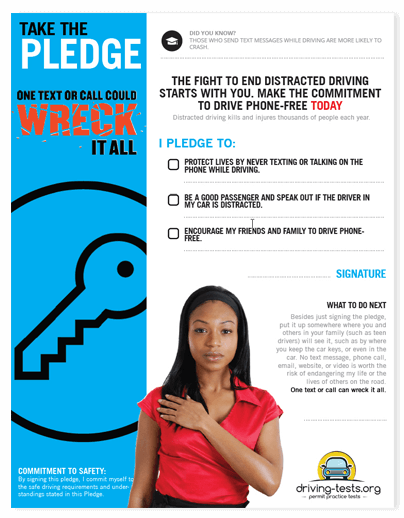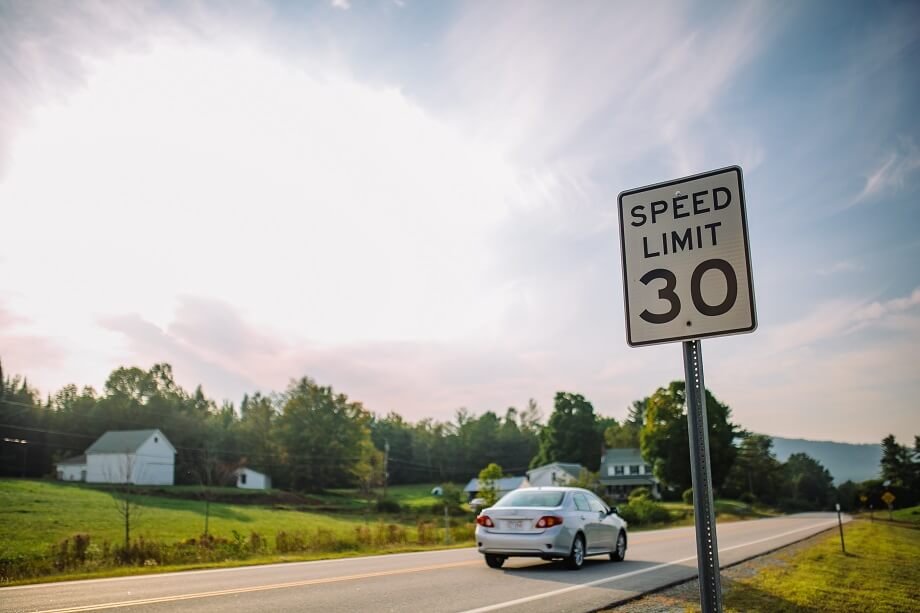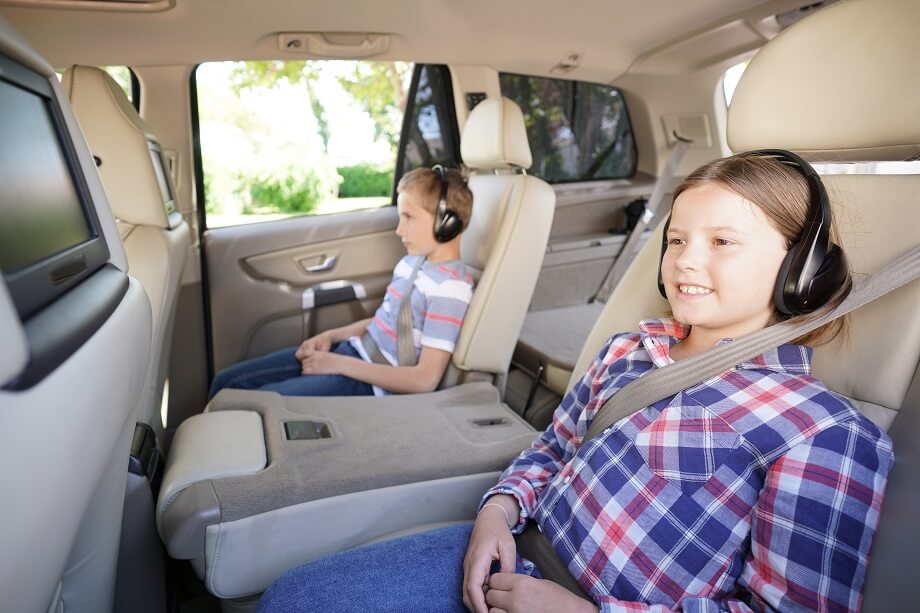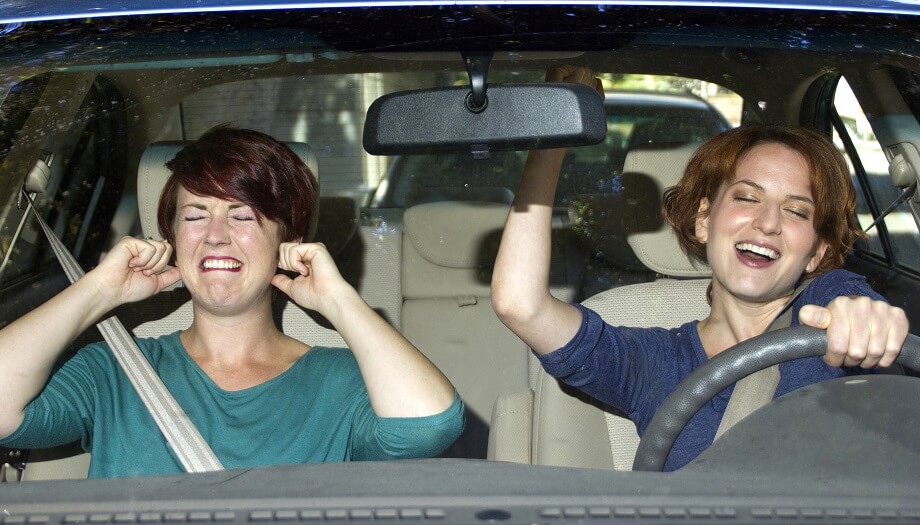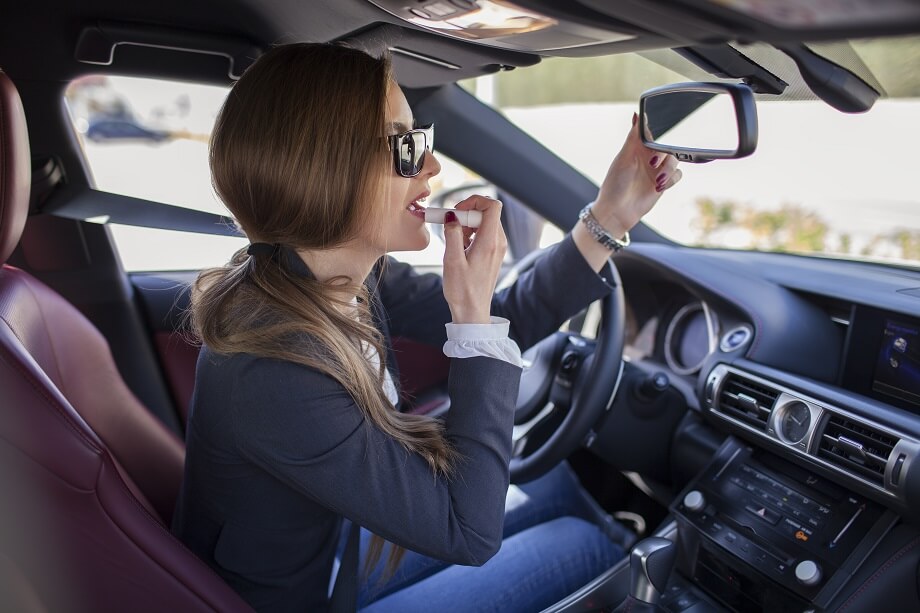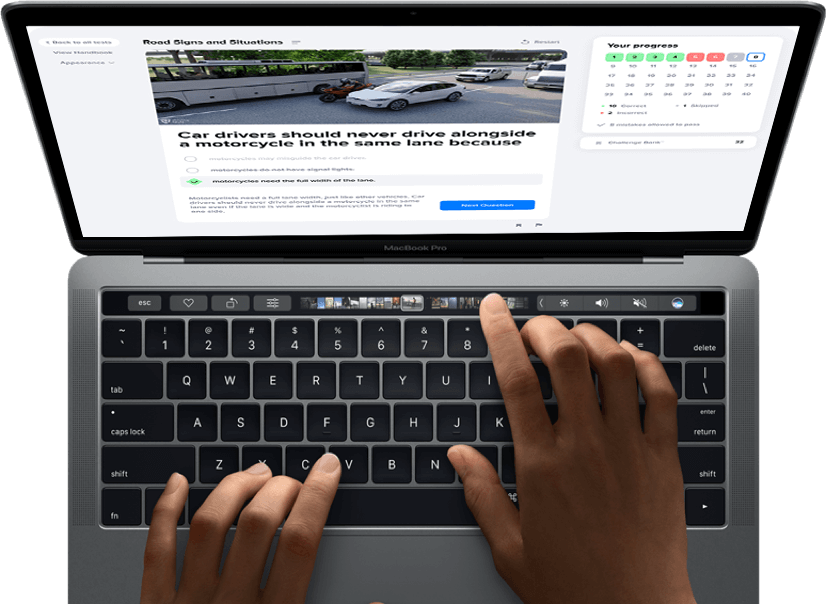Distracted driving causes a large amount of physical damage and claims many lives each year. There is more to distracted driving than texting, such as grooming, eating, and more. These visual, manual, and cognitive tasks can wait for when you are not at the wheel. Awareness and safety is important, so learn about these dangers to help stop distracted driving and help save lives.
You’re reading one of our “Beginner Driver’s Guide” articles. Need to practice for your upcoming exam? Take our free sample driving test -- no registration required! ✨
Distracted Driving Facts & Statistics
Not many people understand the risks involved when driving while distracted. The fatal outcomes of distracted driving are preventable, with the right knowledge and awareness of the subject. The following are a few distracted driving facts & statistics:
- 25% of all motor vehicle crash fatalities are caused by distracted driving.
- 58% of teen crashes involve distraction while driving.
- 391,000 injuries were the result of distracted driving in 2015.
- Distracted driving kills approximately 9 people in the U.S. each day.
- Car crashes are responsible for the most deaths of teens in the U.S.
- Drivers that aren’t paying attention or distracted drivers causes 80% of car crashes.
- The chance of an accident is 6 times more likely when texting and driving than driving under the influence of alcohol.
- There are 16 states that prohibit the use of any handheld cell phones while driving.
- There are 47 states that prohibit text messaging while driving.
- Distracted driving can not only lead to injuries and death, but also higher insurance premiums, large fines, and more.
Dangerous Driving Habits
Safe driving requires concentration and care, but we do it so often, sometimes we become overconfident and develop bad habits. Dangerous behavior can cause accidents on the road. Here are five bad driving habits and what to do to break them.
- 1
Driving Under the Influence
Driving under the influence continues to be the number-one cause of vehicular fatalities in the U.S. Three people are killed every two hours in an alcohol-related car accident, according to the Department of Transportation. Though the U.S. has seen significant decreases in the number of these accidents since awareness efforts and legal penalties have increased, many drivers still feel they are okay to drive if they’ve “only had a couple drinks.” This simply is not true. The only sure-fire way to avoid impairment while driving is to not drink at all.
A blood-alcohol level of .08 percent can land you in deep trouble and compromise your reaction time significantly enough to cause serious damage. All 50 states have adopted the .08 percent legal limit, but for drivers under the legal drinking age, this rule does not apply. If you are underage and impaired, any alcohol level is cause for arrest and DWI or DUI charges.
Consequences for the diver can include jail time, community service, fines, and monitoring devices. Worse yet, they can result in injury or death of passengers or others on the road.
Here is how to calculate your blood alcohol level:
- 2
Drowsy Driving
Many propose that driving while tired is just as risky and dangerous as driving under the influence. Certain demographics are more prone to driving while fatigued than others, with young people between the ages of 16-29 (particularly young men) being the most likely to fall asleep at the wheel, as noted by the National Highway Traffic Safety Administration (NHTSA). Research hypothesizes this heightened risk is because of the natural maturation effects that teenagers experience. The need for more sleep and changes in sleep patterns, in addition to lifestyle influences like school demands, jobs and extracurricular activities, mean that teens are often not well-rested before they get behind the wheel.
Here is more about drowsy driving:
- 3
Distracted Driving
Rapidly becoming the dangerous driving epidemic of the modern age, distracted driving includes all of the temptations a cell phone offers: texting, talking on the phone, checking email and posting to social media. Again, teens are the most susceptible to distracted driving accidents, with drivers under the age of 20 having the highest proportion of fatal distracted-driving car accidents, according to the Centers for Disease Control (CDC). Distracted driving also includes other bad habits we’ve developed to save time, like applying makeup and eating.
Wait until you get to your destination to text or call. If it’s urgent, pull over into the parking lot of a shopping center. Pledge It Can Wait, a campaign to keep eyes on the road rather than on the phone.
If you stop to grab food, eat it in your car or at the food place before you venture back out onto the road. It’ll only take a few minutes and then you’re not scarfing it down while you try to navigate your way back onto the freeway.
The following video shows the outcome of the study conducted on one of the US highways which aim was to check the number of distracted drivers on the road:
- 4
Speeding
The road rule here is simple: the more speed involved, the greater the severity and risk of an accident. Speeding drastically reduces a driver’s ability to maneuver and control the vehicle and increases the distance required to stop a vehicle. Young people are the most likely to be involved in a speeding-related accident, with drivers ages 15-20 the most frequently cited demographic to be cited for the offense, as noted by the NHTSA.
Avoid this high-risk habit by knowing the rules of the road, even before beginning to drive. Pay attention to the current speed limits, be patient and be aware of those driving around you.
![]()
- 5
Driving Without a Seatbelt
Wearing a seatbelt is hands-down the simplest way to prevent potential injury in the event of an accident. Though airbags are a great feature intended to reduce injury in car accidents, they are specially designed to be effective when used in conjunction with a seatbelt. An airbag alone will not save you, and since, according to the CDC, more than 50 percent of teens age 13-20 killed in vehicle collisions in 2012 were not wearing a seatbelt, it is hazardous to drive without engaging yours. Here is how to buckle up properly:
Driving is a privilege and we should treat it as such. Teens are particularly susceptible to picking up bad habits since they’re new to driving. Check out this Parent-Teen Contract. It helps hold teens accountable for their driving habits. Developing good driving habits, and avoiding perilous ones will make you a conscientious and safe driver.
In-Car Distractions to Be Aware Of
- 1
Cell Phones
Most drivers, even those who are old enough to remember the days before car phones, cannot fathom travelling from one destination to another without the “safety” of having a cell phone available. The fact is, cell phones are much more likely to cause an automobile accident than they are to save a life after one. It is best to turn off your cell phone or turn it on silent while operating your vehicle. It is also advisable to ask your passengers to refrain from talking on the phone while you are driving if their conversations distract your attention from the road. We all know that texting and driving is now one of the leading causes of accidents and many states are now adopting laws preventing it. Never send a text message, review email, play a game, or surf the internet from your phone while operating an automobile. The following video discusses the dangers of cell phones:
- 2
Global Positioning System Devices (GPS)
Many vehicles now come with GPS or navigational devices built right into the dashboard. Directionally challenged drivers swear by these instruments and many refuse to drive anywhere without them. While GPS devices are very helpful, they can be just as distracting as cell phones. If your device is removable, always position it in the proper location on your windshield and input your destination before you being to drive the vehicle. If it malfunctions while you are driving, pull over and stop your car before you attempt to fix it. It is safest to designate a passenger to use the GPS device so that your eyes and attention are not drawn from the road.
![]()
- 3
Passengers
Let’s think about all the people who ride along with us as we operate our vehicles: a passel of gossipy coworkers on our morning commute, half of our son’s soccer team after a devastating and emotional loss, our back-seat driving in-laws, four giddy friends on the way to the beach, and the list goes on and on. Passengers can be extremely distracting. Remember, you are not only in control of the vehicle, you are in control of the safety of those inside it. Don’t worry about being cool. If you need to ask your passengers to talk more quietly or exclude you from their conversations so that you can focus on driving, do it. If you know that driving with passengers distracts you, limit the number of people who ride in your car or allow someone else to drive.
![]()
- 4
Car Video Players
Many family vehicles are now equipped with DVD systems that allow passengers riding in the back seat to watch movies while the vehicle is in motion. While many of these systems have headphones for the viewers to wear, the audio is often played through the vehicle’s speakers. While these systems may keep your kids or passengers content on long drives, they also subject the driver to spontaneous burst of laughter, plot synopsis, and the task of controlling movie features and volume while the vehicle is in operation. It is best to make your passengers wear headphones if your vehicle has them or at least keep the movie’s volume low.
![]()
- 5
Music
There’s nothing quite like rolling down the windows and heading down the highways while listening to your favorite songs on your car’s radio. However, if you are using your drink as a microphone, squinting your eyes for the high notes, and your speakers are precariously close to bursting, it is likely that your radio has become a distraction. Listen at reasonable volume levels, keep your eyes on the road when you change channels, and stop the vehicle before you search for a new CD or program the stations.
![]()
- 6
Smoking
It is universally recognized as being horrible for your health. Did you know that smoking can adversely affect your driving also? Most smokers drive with only one hand on the wheel while they are smoking. Many also fumble through their belongings for their lighter or cigarette package while attempting to drive their car. The first way to prevent this distraction is to stop smoking. If you do smoke, make sure to light up before you begin to operate your vehicle and do your best to keep both hands on the wheel.
![]()
- 7
Eating and Drinking
The advent of the drive-thru restaurant was an American phenomena and almost all of us visit these fast-food joints a couple of times each week. Just because you can order food from your car doesn’t mean that you should eat it inside your car. Keep the burgers in the bag until you get to your destination.
![]()
- 8
Grooming and Self-Care
Ladies, waking up five minutes earlier will prevent the need for you to apply your make-up and fix your hair while driving on the expressway. Merging while applying your lipstick is the epitome of distracted driving. For men, shaving while driving is also distracting, alongside brushing your teeth and other grooming and self-care routines.
![]()
Many of these distractions are things that we do almost every single time we get into our vehicles. Remember that operating an automobile is a huge responsibility. You are taking your own life, the lives of your passengers, and the lives of those on the road with you into your own hands. Take the task of operating a vehicle seriously and do your best to leave the distractions behind.
Tips to Stop Distracted Driving
The thing most people say after having an accident is that they only took their eyes away from the road for a second. That’s the thing — too many people have years of safe driving and become a little too comfortable and take too many liberties with safe driving habits. The simple act of regularly checking your mirrors often gets neglected over time, as does making sure you have both hands on the wheel and readiness to keep the vehicle in control.
Truth be told, comfortable and confident drivers do actually make better drivers. It means they are also more able, usually, to make quick decisions and have really good defensive driving skills. The problem is when motorists become too comfortable and confident behind the wheel for their own good — and the good of everyone else sharing the road. If you feel that your driving has become too risky, consider the course created by National Safety Council.
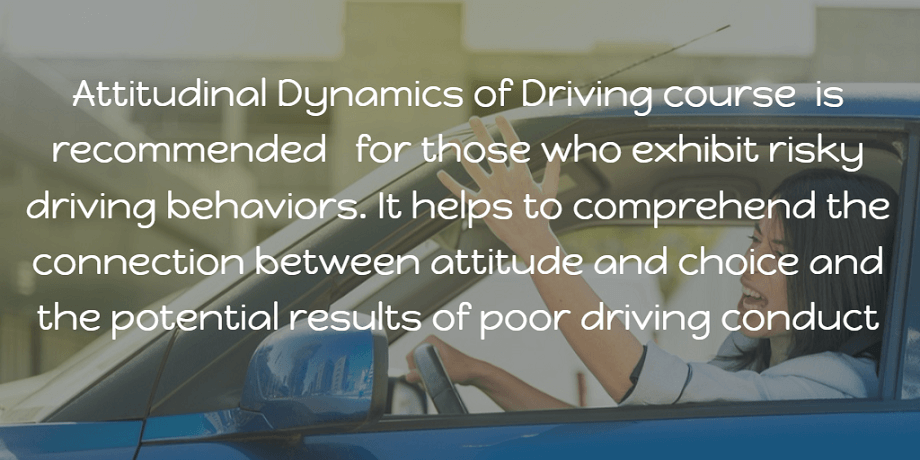
So, it seems the first bit of advice about avoiding distracted driving should simply be to not allow yourself to be distracted. It’s not like getting tired while driving, which can be beyond your control. To be realistic though, it’s about finding some ways to limit what you allow to grab your attention and make you a potential hazard on the roads.
- 1
Just Say No to the Cell Phone
Not only is texting or talking on a cell phone a bad idea, it is actually illegal in many states. Some areas have only banned texting, but that doesn’t mean that talking on the phone is that much safer. Reports have indicated that, contrary to popular belief, giving attention to a caller on the other end of the phone is much more distracting than having a conversation with someone who may be riding in the car with you. Anything that takes your attention from the road is a distraction. So, obviously, the more attention the activity requires, the more distracted you are.
That doesn’t mean you will able to avoid this recent advancement in technology, which has led to an entire society of people who pay more attention to the gadget in their hands than anything in front of them. If you are really determined to stop letting your phone cause you to have questionable driving habits, turn it off. Before getting in the car, simply shut it down. That way, you still have it should an emergency arise, but you are not as tempted to make a call, take a call or, even worse, start typing a text message.
![]()
If the need does arise to do any of these things, or use the phone to map out directions or some similar useful function, at least pull over to the side of the road prior to using the phone. Even typing an address into your phone for GPS tracking can be the cause of a wreck. Pull off to a safe spot on the side of the road or to a gas station or rest area and take care of what you need to. Keep in mind, this applies to all electronic devices. Searching for a song on your iPhone isn’t any safer than using your phone as a method of distraction.
- 2
Save the Grooming for the Bathroom
While women are guilty of doing things such as applying makeup and using the rear view mirror as a vanity mirror, men, too, have been known to shave, comb their hair or otherwise groom in the car. Aside from being a distraction, it often means one or, even more frighteningly, both hands are no longer on the steering wheel. Plus, it means using the mirrors for things other than the intended purpose. Either plan your time better in the morning so you can spend time at home getting ready, or allow yourself a few moments in the employee facilities to finish up your morning grooming.
![]()
Unfortunately, this also includes putting in contacts, cleaning your glasses or even, for vehicular grooming, attempting to clean either part of the car interior or windshield, while driving. While these things may actually serve an important and useful function, they are also tasks that should be performed while the car is stopped. The bottom line is that multi-tasking while driving should not be an option.
- 3
Emotional Distractions
Believe it or not, emotional driving can be a distraction, too. This type of unsafe driving means your mind is not on the road ahead, even if your eyes are. Emotional driving can be being upset, sad or mad about something personal before getting behind the wheel, or it may also mean getting caught up in a case of road rage. Whatever the type of emotional distraction, it can be a truly problematic issue.
It would be great to say no one should ever get behind the wheel of a car until they have completely gained control of their emotions. This, unfortunately, would not be entirely realistic. The trick is to, first, calm down as much as possible. Take some deep breaths and really remind yourself that, for the time being, the focus has to be the driving, not the thing upsetting you so much. Secondly, once you have started driving, keep things in check. If you feel your emotions flaring up again or just can’t seem to stop being distracted, you may need to pull over until you regain some more composure.
If you tend to suffer from road rage, this is something you certainly need to try to keep in check. This is not only dangerous and distracted behavior, it can be destructive, as well. This type of behavior usually causes those who suffer from it to actually try to instigate a fight or cause a wreck. If you know you suffer from road rage you should really try some self-help methods to help cure this, or even seek help such as anger management courses or therapy. Here is more about preventing yourself from being mad on the road:
- 4
Drive Responsibly
When it comes to acting as responsible motorist who has the opportunity to have the freedom to be behind the wheel, the idea is to treat it as importantly on day one as you do year one as you do year 100. Also, learn good defensive driving skills so you can protect yourself from other drivers who may be distracted.
Take the Pledge to End Distracted Driving!
Now that you are aware of the dangers of distracted driving and have actionable tips to stay aware and stay alive, take the pledge to end distracted driving.
Driving-Tests.org has joined this year’s National Distracted Driving Awareness and Enforcement Month.
What’s the deal? This effort is intended to educate our community about the dangers of cell phone use and other distractions while driving. Once people see the statistics and realize the danger involved, we believe they will change their driving habits to help protect themselves, their families, and others on the road.Distracted driving kills and injures thousands of people each year and you can help make a difference. Take the pledge and make the commitment to drive phone-free today. Join us in reaching out to other teens and their parents to spread the word about this dangerous habit.
I pledge to:
- Protect lives by never texting or talking on the phone while driving.
- Be a good passenger and speak out if the driver in my car is distracted.
- Encourage my friends and family to drive phone-free.

